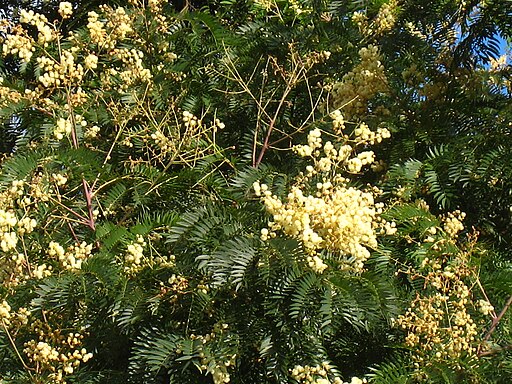
Classification System: APG IV
Superregnum: Eukaryota
Regnum: Plantae
Cladus: Angiosperms
Cladus: Eudicots
Cladus: Core eudicots
Cladus: Rosids
Cladus: Eurosids I
Ordo: Fabales
Familia: Fabaceae
Subfamilia: Caesalpinioideae
Tribus: Acacieae
Genus: Acacia
Species: Acacia elata
Name
Acacia elata A.Cunn. ex Benth., 1842
Synonyms
Acacia bilaura Buch.-Ham. ex Wall.
Acacia odoratissima Buch.-Ham. ex Wall.
Racosperma elatum (A.Cunn. ex Benth.) Pedley
Homonyms
Acacia elata (Roxb.) Voigt = Albizia procera (Roxb.) Benth.
Distribution
Native distribution areas:
Acacia elata
Continental: Australasia
Regional: Australia
New South Wales
Introduced into:
California, Cape Provinces, India, Jawa, Kenya, New Zealand North, New Zealand South, Sri Lanka, Uganda, Victoria, Western Australia, Zimbabwe
References: Brummitt, R.K. 2001. TDWG – World Geographical Scheme for Recording Plant Distributions, 2nd Edition
References
Primary references
Cunningham, A., 1842. London Journal of Botany. London : 383
Links
Govaerts, R. et al. 2020. Acacia elata in Kew Science Plants of the World online. The Board of Trustees of the Royal Botanic Gardens, Kew. Published on the internet. Accessed: 2020 Aug 02. Reference page.
International Plant Names Index. 2019. Acacia elata. Published online. Accessed: Aug 02 2019.
Tropicos.org 2019. Acacia elata. Missouri Botanical Garden. Published on the internet. Accessed: 2019 Aug 02.
Hassler, M. Aug. Acacia elata. World Plants: Synonymic Checklists of the Vascular Plants of the World In: Roskovh, Y., Abucay, L., Orrell, T., Nicolson, D., Bailly, N., Kirk, P., Bourgoin, T., DeWalt, R.E., Decock, W., De Wever, A., Nieukerken, E. van, Zarucchi, J. & Penev, L., eds. Aug. Species 2000 & ITIS Catalogue of Life. Published on the internet. Accessed: Aug 02 {{{3}}}. Reference page.
USDA, ARS, Germplasm Resources Information Network. Acacia elata in the Germplasm Resources Information Network (GRIN), U.S. Department of Agriculture Agricultural Research Service. Accessed: 09-Oct-10.
Vernacular names
English: Cedar Wattle, Mountain Cedar Wattle
Acacia elata the cedar wattle or mountain cedar wattle is a tree found in eastern Australia.[4]
Description
The tree can grow to a height of around 20 m (66 ft) when mature, with exceptional specimens reaching over 30 m (98 ft). It has deeply fissured bark with a dark brown to black colour at the base of the tree with terete branchlets that are hairy when young. The dark green evergreen leaves typically have a length of 2.5 to 9 cm (0.98 to 3.54 in) with one prominent gland about halfway along. There are usually three to seven pairs of pinnae with a length of 7 to 23 cm (2.8 to 9.1 in) with 8 to 22 pairs of discolourous pinnules that have a lanceolate shape and a length of 2 to 5 cm (0.79 to 1.97 in). It blooms between December and February producing inflorescences in panicles or racemes with spherical flower-heads that have a diameter of 7 to 10 mm (0.28 to 0.39 in) and contain 30 to 55 pale yellow to cream coloured flowers. The straight, flat seed pods that form after flowering have a length of 4 to 17.5 cm (1.6 to 6.9 in) and a width of 9 to 15 mm (0.35 to 0.59 in) that are firmly papery to leathery.[4]
Taxonomy
The species was first formally described by the botanist George Bentham in 1842 as part of William Jackson Hooker's work Notes on Mimoseae, with a synopsis of species as published in the London Journal of Botany. It was reclassified as Racosperma elatum by Leslie Pedley in 1987, then returned to genus Acacia in 2006. It is sometimes confused with Acacia terminalis.[5] The specific epithet refers to the plants tall, tree-like habit.[4]
Distribution
The species is endemic to coastal areas of New South Wales. Its native range extends from the Budawang Range in the south as afar as the Bellinger River in the north.[4] It is sometimes escaping from gardens and is considered as a weed in wetter Warren and Jarrah Forest regions in the South West of Western Australia where it grows in loamy lateritic soils.[6] It has also become naturalised in other parts of Australia including Queensland and parts of Victoria.[4] The habitat is near rainforest and wet sclerophyll forest in various situations. An attractive plant with delicate foliage, it is sometimes seen in cultivation. Its timber is attractive, close-grained, strong and hard, and is suitable for carpentry and turning.
See also
List of Acacia species
References
"Acacia elata". Australian Plant Name Index, IBIS database. Centre for Plant Biodiversity Research, Australian Government.
Bentham, G. (1842). Hooker, W.J. (ed.). "Notes on Mimoseae, with a synopsis of species". London Journal of Botany. 1: 383.
ILDIS LegumeWeb
"Acacia elata". PlantNET - NSW Flora Online. Royal Botanic Gardens, Sydney. Retrieved 2 August 2019.
"Acacia elata A.Cunn. ex Benth". Atlas of Living Australia. Global Biodiversity Information Facility. Retrieved 2 August 2019.
"Acacia elata". FloraBase. Western Australian Government Department of Parks and Wildlife.
Further reading
Castro-Diez, P.; Langendoen, T.; Poorter, L.; Saldana-Lopez, A. (November 2011). "Predicting Acacia invasive success in South Africa on the basis of functional traits, native climatic niche and human use". Biodiversity and Conservation. 20 (12): 2729–2743. doi:10.1007/s10531-011-0101-5. S2CID 41606801.
Donaldson, J.E.; Richardson, D.M.; Wilson, J.R.U. (September 2014). "The seed ecology of an ornamental wattle in South Africa — Why has Acacia elata not invaded a greater area?". South African Journal of Botany. 94 (1): 40–45. doi:10.1016/j.sajb.2014.05.004.
Korit, Alexander; Jermyn, Michael (March 3, 2005). "Acacia Proteinase Inhibitors Purification and Properties of the Trypsin Inhibitors from Acacia elutu Seed". European Journal of Biochemistry. 115 (3): 551–557. doi:10.1111/j.1432-1033.1981.tb06238.x. PMID 7238519.
Rehman, S.; Harris, P. J. C.; Bourne, W.F. (1998). "The effect of seed hardening on the salinity tolerance of Acacia seeds". Seed Science and Technology. 26 (3): 743–754.
Retrieved from "http://en.wikipedia.org/"
All text is available under the terms of the GNU Free Documentation License


